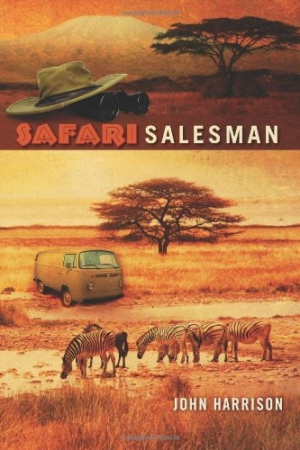Safari Salesman
Safari Salesman is a lively and impressively detailed account of UK native John Harrison’s several months spent on the road in Africa in 1959 and 1960, when he traveled the bush peddling cosmetics, household equipment, and over-the-counter medicines.
This account was written nearly fifty years after the events took place, yet the details of the journey read like a travel guide written for today’s adventurers. Either Harrison has a remarkable memory or he kept a comprehensive journal throughout his adventures.
Like a news correspondent, Harrison provides a great many facts and descriptions without flowery embellishment. Regarding his drive through Kenya, he writes: “The drive was through a typical savanna of open grassland dotted with winter thorn trees. Some rather grubby ostriches looked disdainfully down from a grassy slope, necks twisting, before pacing gravely away from the yellow dust that billowed from the back wheels of the van.”
Harrison also describes his romantic encounters with several women he meets along the way. These relationships are never fully developed, and none of the women ever reappear for a second engagement. The trysts are essentially one-night stands of the kind often associated with traveling salesmen.
During the course of his journey, Harrison and his traveling companions confront various dangers, including wild beasts and the vagaries of civil war. At one point, he reports how his group became embroiled for a very short period in transporting refugees caught up in the fighting that was then going on in the Congo. There is no full discussion of the issues involved, other than that the refugees needed rescuing. The episode is mere background to the ongoing journey.
Harrison shares his adventures with Thomas, his African driver, and Vinoo Visavadia, the company’s Indian sales representative. But it is clear there is a stratified society in the van. Thomas and Visavadia rarely dine with Harrison. In fact, Harrison spends little time describing the character or personality of these two sidekicks, except to say they are reliable and competent, each in his own way. Possibly, this is an accurate reflection of the way things were in Africa in 1960. Yet at the very end of the story, the reader can see that these three men share true affection: “This ‘saying good-bye’ was a bigger wrench than I had expected, and a mood of sadness took hold of me,” Harrison says.
The cover art for the book, a picture of zebras grazing on the African plain with a Volkswagen van in the background, is colorful and inviting. What is lacking, however, is any biographical information on the author, John Harrison. It would lend authenticity to the book and give it a greater sense of place and time had this material been included. Nonetheless, Safari Salesman is a good tale for armchair travelers to enjoy.
Reviewed by
John Senger
Disclosure: This article is not an endorsement, but a review. The publisher of this book provided free copies of the book and paid a small fee to have their book reviewed by a professional reviewer. Foreword Reviews and Clarion Reviews make no guarantee that the publisher will receive a positive review. Foreword Magazine, Inc. is disclosing this in accordance with the Federal Trade Commission’s 16 CFR, Part 255.

